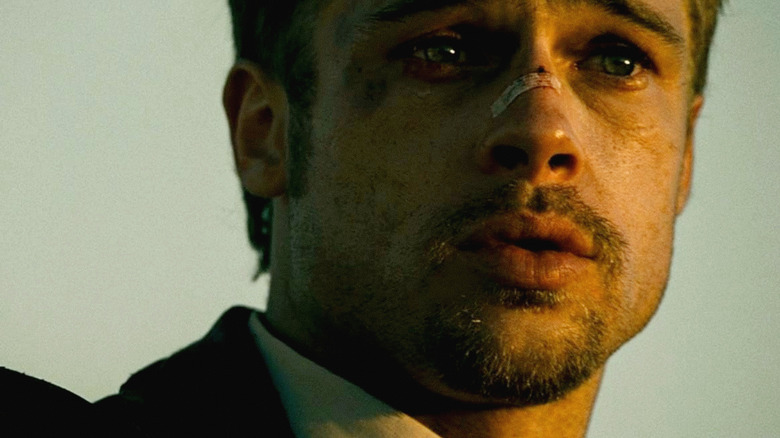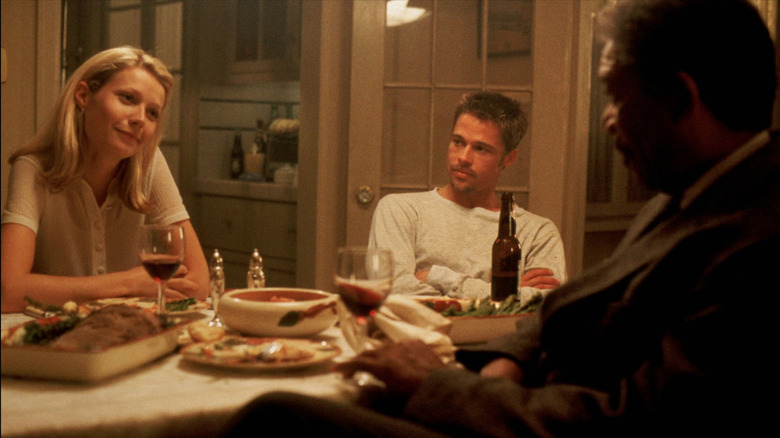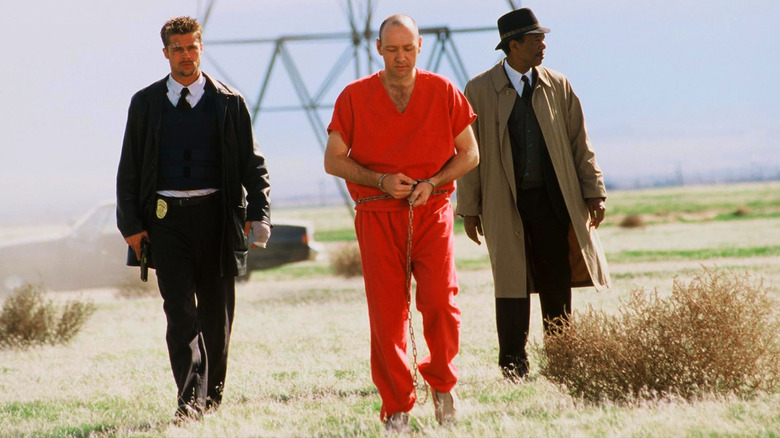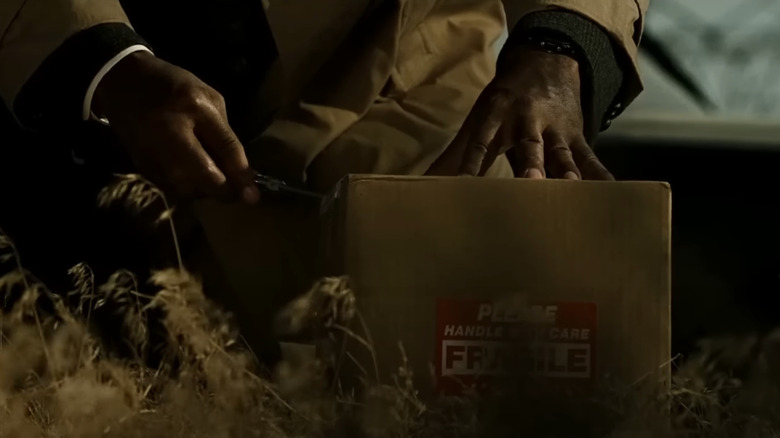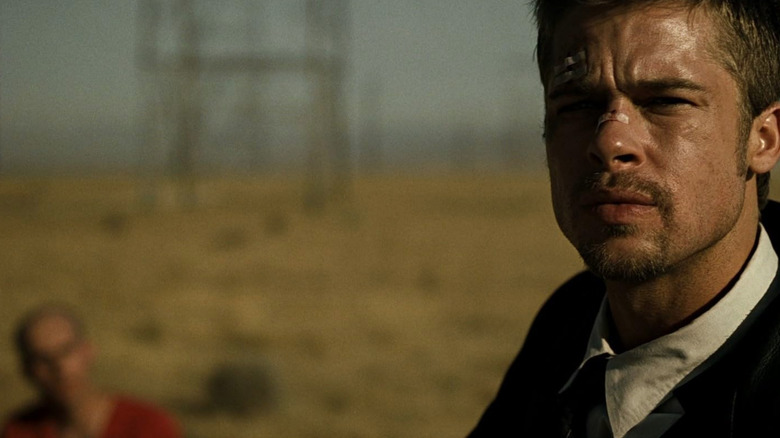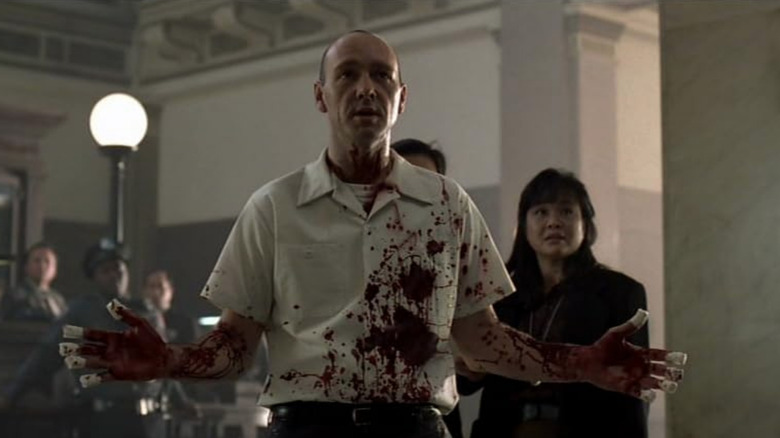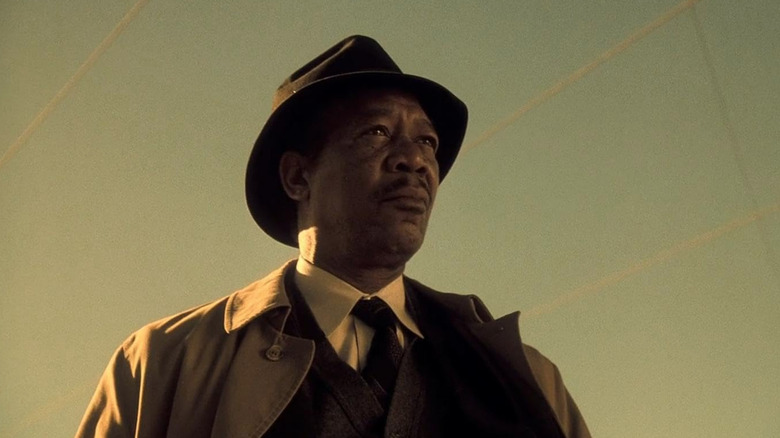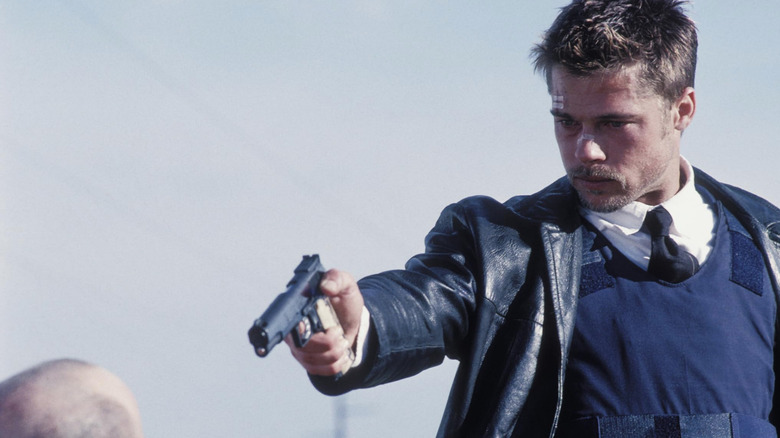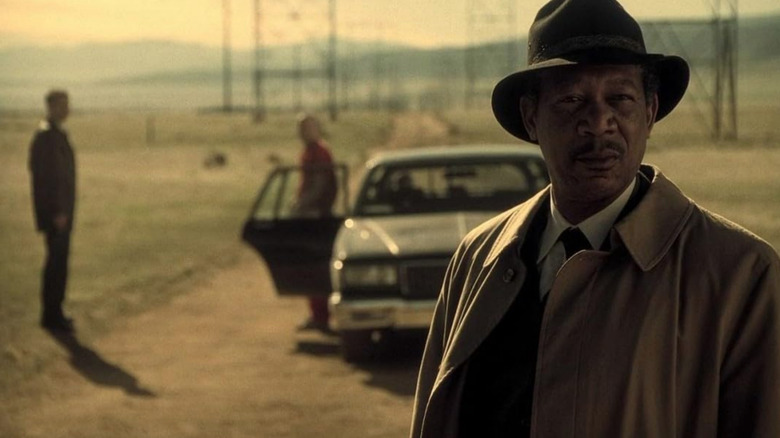Seven Ending Explained: The Power Of Evil And The Limits Of Apathy
It's hard to imagine "Seven" without its intense climax. As modern crime thrillers go, they don't get much better than David Fincher's 1995 effort, which truly established the arrival of the director as a subversive talent within Hollywood. "Seven" was a hit, becoming the 12th biggest film of the year domestically despite lackluster expectations and being what Brad Pitt called in an LA Times interview, "The feel-bad movie of '95."
The movie's shocking finale had a lot to do with that success, but it wasn't just a "twist ending" that propelled it. Fincher crafted a visceral world of grime and decay which, draped in cinematographer Darius Khondji's minimal lighting, became oddly alluring. Morgan Freeman and Brad Pitt as detective duo William Somerset and David Mills delivered compelling performances, with Freeman in particular arguably at the apex of his career. But there's no escaping that ending, which delivers a gut punch of a denouement before the final fade to black.
The phrase "what's in the box" has become somewhat of a meme in and of itself in the decades since "Seven" was released. The line is delivered by Mills in the film's final moments, as he begs his partner to reveal what's in a mystery package delivered from Kevin Spacey's serial killer, John Doe. Of course, it was Mills' wife's head in that box. But somehow never having it visually confirmed makes it all the more haunting. Even Mills doesn't have to see the contents in order to give in to his vengeful rage and shoot John Doe.
But what was the point of putting poor old Mills through such agony to cap off the movie? Well, we've gone ahead and done some hardboiled detective work of our own to solve this case.
What you need to remember about the plot of Seven
Like a practiced serial killer, "Seven" drops subtle clues about where it's headed throughout. The film begins with world-weary detective William Somerset (Morgan Freeman) shuffling around his dingy apartment before that ground-breaking credits sequence unfolds. Having witnessed decades of crime and degradation plague the unnamed city in which he lives, Somerset is adrift in a sea of apathy and pessimism ahead of a rapidly approaching retirement. But before he can leave, he's teamed up with young, idealistic, and hot-tempered Detective David Mills (Brad Pitt) to take on the case of a serial killer that uses his victims as centerpieces in gruesome, theologically-inspired tableaus.
Mills has just moved to the city with his wife, Tracy (Gwyneth Paltrow), who's struggling to adapt to life in the harsh, crime-addled environment. She confides in Somerset that, much like him, she's yearning to escape — especially because, unbeknownst to her husband, she's pregnant and doesn't want to raise a child in the city.
Meanwhile, Somerset and Mills investigate yet more horrific crime scenes as the serial killer known only as John Doe (Kevin Spacey) continues his murders inspired by the seven deadly sins: gluttony, greed, sloth, lust, pride, envy, and wrath. But before the pair have the satisfaction of arresting their man, he turns himself in at the police station, covered in blood and addressing himself directly to Mills.
Once in custody, Doe reveals that unless the two detectives accompany him to an unnamed location, he'll plead insanity and likely get off with a reduced sentence. On top of that, he'll never reveal the location of his final two victims — envy and wrath — forcing Mills and Somerset to agree to his demands.
What happened at the end of Seven?
You likely won't have any trouble remembering the harrowing finale of "Seven." But in case you're confused about what exactly played out, here's a précis.
After Detectives Mills and Somerset agree to John Doe's request, the trio drive out to a barren desert location beneath a sea of "high tension" power lines. Mills forces Doe to get on his knees and holds him at gunpoint as a delivery truck makes its way towards them. Somerset leaves Mills and Doe behind to meet the truck, as the serial killer explains how he admires Mills and his life with Tracy. "It seems that envy is my sin," he utters ominously, as the delivery driver hands Somerset a package. The Detective opens the box and recoils in horror, while Doe reveals he killed Tracy and took her "pretty head," strongly suggesting that's what's in the package.
As Somerset returns and pleads with Mills to put his gun down, his distressed partner repeatedly asks "what's in the box." Doe says that Tracy begged for her life and "the life of the baby inside her," revealing the pregnancy to Mills. He then encourages the Detective to kill him and "become wrath," thereby completing his seven sin-inspired murders. And just to cap off the already shocking sequence, Mills does exactly that, shooting Doe in the head and becoming the final sin.
A final scene sees Mills siting motionless in the back of a police car. The Police Captain (R. Lee Ermey) asks Somerset where he's going to be, to which he replies, "Around, I'll be around." A final line from Somerset comes via voiceover: "Ernest Hemingway once wrote, 'The world is a fine place and worth fighting for.' I agree with the second part."
What the ending of Seven means
So, what was the point of all that misery? It's complicated, because the version of "Seven" we all saw actually wasn't the version David Fincher intended — no wonder Fincher said he'd direct "Seven" differently if he had another chance. We'll return to that point later, but based purely on the theatrical cut we all know, "Seven" is about the limits of apathy, the power of evil to infect and corrupt even the most steadfastly moral people, and the symbiotic relationship between light and dark.
Detective Somerset remains firmly apathetic throughout the film, looking forward to retiring and escaping the hell hole of a city he spent his career trying to protect. Mills, meanwhile, is somewhat of a mirror image of John Doe. He, too, is disgusted by the moral decay surrounding him but rather than punishing the "sinners" he's engaged in a personal crusade against the darkness to preserve morality by legal means.
In "Seven," then, you have Doe on one end of the spectrum — a punisher who has witnessed the depravity of his city and taken it upon himself to mete out judgment. Mills, with his zealous opposition to criminality, occupies the other end of the spectrum, and in the middle you have Somerset, jaded and disconnected from it all.
But after witnessing the horrific events of the finale, Somerset tells his police captain that he'll "be around," and in the final voiceover says the world is "worth fighting for." This suggests that he's been shaken out of apathy and will defer retirement to try to make a positive difference. In that sense, despite its unrelenting savagery, "Seven" manages to sneak in a redeeming note, suggesting that even out of the bleakest dark can come light.
Another possible explanation of the ending of Seven
Writer Andrew Kevin Walker wrote "Seven" after moving to New York City in the '80s and witnessing widespread crime and social decay. As he told Uproxx:
"The idea — 'seven deadly sin murders' — was a reaction to living in New York and putting myself in a John Doe head space where you could walk down the street and see every "deadly sin" on every street corner."
You can sense Walker's New York experience in John Doe's speech in the car at the end of "Seven." The killer says, "We see a deadly sin on every street corner, in every home, and we tolerate it. " He then goes on to say, "Wanting people to listen, you can't just tap them on the shoulder anymore. You have to hit them with a sledgehammer."
After the ending of "Seven," you get the sense that the film was Walker's attempt to hit the audience with a sledgehammer and perhaps make a point about society's proclivity for overlooking immoral acts, or at least people becoming desensitized to it. "Seven" is Walker's "head in a box," forcing people to pay attention with its brutal finale. John Doe turning himself in to the police is similarly designed to shock viewers, which Walker told Entertainment Weekly, "steals a lot of the satisfaction away from not just the characters in the movie but the audience."
The writer even tells us what's going to happen before it does, with Somerset telling Mills earlier in the film that, "This won't have a happy ending." Were you paying attention? By the end, you most certainly are.
What Seven wants viewers to think
There's more to this theory of the ending of "Seven" being a comment on society's indifference to suffering and violence. As previously mentioned, "Seven" wasn't expected to become a hit. In fact, like so many casual crimes witnessed by its writer in his NYC days, this dingy downer of a movie could have been easily overlooked by the moviegoing public. But it's that gut punch of an ending that makes it not only difficult to overlook, but impossible to forget. The film remained number one at the box office for four weeks, suffering only minor drops in attendance between each, suggesting that word of mouth played a big role in helping it maintain its popularity. In other words, people were paying attention.
With that in mind, the ending of "Seven" functions as Andrew Kevin Walker's own personal triumph over apathy. He's managed to get your attention with a third act that dares you to look away. On top of all that, both David Fincher — whose new movie "The Killer" is on the way — and Walker have forced their audience to do a lot of the work themselves. You never actually see any of the sin murders take place, you don't know the name of the city, you don't even see the head in the box. And there's something even more disturbing about that, because it's forcing the audience to use their imagination, giving the movie this sense that parts of it are playing out in your own head rather than on the screen. How are you going to ignore something that happens inside your own mind? That's the challenge "Seven" sets and drives home with its tumultuous finale. By the film's end we've become Somerset, previously removed and numb but chastened by the events we've witnessed.
What has the cast and crew of Seven said about the ending?
Speaking to Uproxx, Andrew Kevin Walker explained that the ending of "Seven" is the crux of the whole thing. The writer said:
"The dark ending of 'Seven' was what it was about. To change the ending to something else was to remove the very heart of the story. It's about 'optimist Mills,' Brad Pitt's character, going up against this pessimistic kind of world-weary detective in Somerset, Morgan Freeman's character. Those dramatically-opposed points of view are pushing and pulling each other throughout the story. And then once pessimism is confirmed, even to the optimist who's been arguing that the fight is always worth fighting, will the pessimist in the light of confirmation of all his worst predictions, will he stay or will he walk away?"
That's what we get with the theatrical cut of "Seven" — a battle between optimism and pessimism that shows the former winning out before a glimmer of hope is offered as Somerset suggests he'll defer retirement.
Speaking to The Guardian, David Fincher recalled how he initially read the script and was blown away by the ending, calling Walker and saying, "This is fantastic, this is so great because I had thought it was a police procedural; now it's this meditation on evil and how evil gets on you and you can't get it off."
The director was so impressed by the ending that it was only Fincher's stubbornness that saved the chilling finale to "Seven" even as the studio was pushing hard to change it to a more upbeat finish. And here's where things get a little complicated. Even after Fincher managed to retain the head-in-the-box finale, he was forced to compromise on the ending, which raises the question of what the finale actually means.
Seven's alternate ending
It wasn't just Fincher that was passionate about the ending of "Seven." Brad Pitt also did everything he could to keep the finale intact, telling Entertainment Weekly:
"With 'Seven,' I said, 'I will do it on one condition — the head stays in the box. Put in the contract that the head stays in the box.' Actually, there was a second thing, too: '[Mills] has got to shoot the killer in the end. He doesn't do the 'right' thing, he does the thing of passion.'
Still, New Line evidently felt the outcome was much too bleak, and pushed for changes even after Fincher had managed to retain the all-important head in a box. Initially the director had intended the movie to cut to black after Detective Mills shoots Doe, enhancing the emotional impact of the scene and forgoing any of the redeeming "the world is worth saving" voiceover from Detective Somerset. This was the alternate "Seven" ending David Fincher wanted us to see, but which never made it to theaters.
Which raises numerous questions about what the ending of "Seven" actually means. If Somerset never had his realization, then his arc would remain incomplete. We wouldn't see him overcome his apathy, we'd just witness evil triumph.
If that was the ending that was always intended, that lends more credence to the view of "Seven" as merely Walker's attempt to gain people's attention. Without the Somerset voiceover, the film becomes more of an exercise in grabbing attention and subverting viewer expectations, and less about how light can come from darkness and the strange symbiotic relationship between good and evil. It is, as Fincher put it, solely a "meditation on evil and how evil gets on you and you can't get it off."
The other alternate endings to Seven
There were several other alternate endings to "Seven." As David Fincher told The Guardian, Andy Walker "had rewritten 'Seven' 13 times in order to make it more 'likeable'" before the director read the script. Fincher was sent Walker's original screenplay, with the head in a box finale, by mistake.
As per The Hollywood Reporter, prior to New Line acquiring the film, "Seven" was optioned by Italian company Penta Film. Bewilderingly, "Christmas Vacation" director Jeremiah Chechik was attached and demanded changes to the script, including removing the shocking ending we all know.
Walker told Uproxx that this updated ending involved, "an abandoned church and the seven deadly sins were depicted in a kind of tableau of paintings." The head in the box was gone, and the ending essentially amounted to a "confrontation in an abandoned church," with Walker adding, "It sounds like the end of Batman." No wonder "The Batman" is basically a "Seven" remake ...
Of course this ending wouldn't be shot once New Line acquired the film and David Fincher came onboard. But there would still be a battle over the film's climax, with the aforementioned voiceover being added to appease the studio. However, before the cut that made it to theaters was decided on, there were several other endings considered for the movie, including one in which Somerset kills Doe instead of Mills in order to spare his partner jail time, and another that even had Mills shooting his partner after murdering John Doe. At one point, New Line attempted to change the end so that it was Mills' dog's head in the box and not Tracy's.
Would any of this have changed what the ending of "Seven" means? Well, yes. Significantly. Thankfully, Walker's original vision ultimately made it to the screen relatively unchanged.
